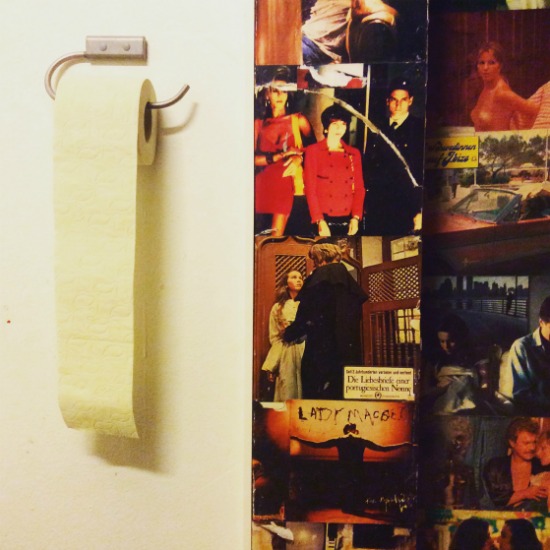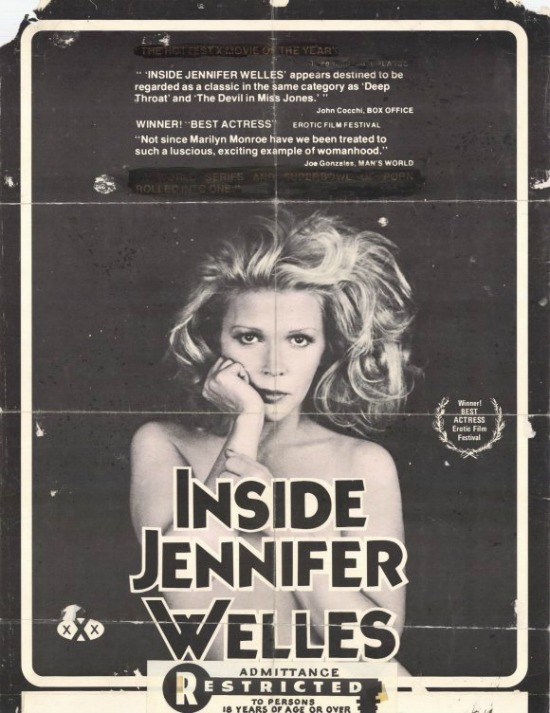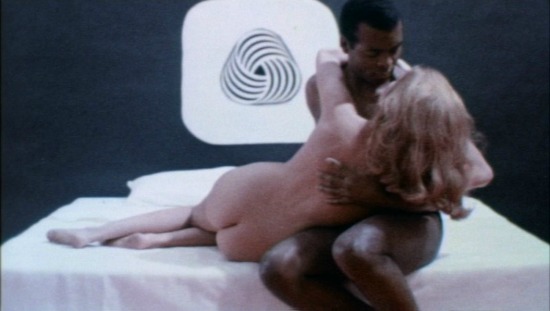“Will people be masturbating in the cinema?” This was one of the most frequently asked questions in the run-up to the first annual Viva Erotica Festival at the WHS Teatteri Union in Helsinki, a four-day long ‘splendid movie orgy’ of thirteen vintage and contemporary films where sex takes centre stage. The organizers were tickled by the question. No, they weren’t expecting any wankers. But if we weren’t meant to be coming together, then what were we doing watching dirty movies in the dark?
The origins of the ‘Splendid Movie Orgy’
Viva Erotica co-founder Milja Mikkola, who also works as the program manager at the legendary Midnight Sun Film Festival, got to know film critic and programmer Olaf Möller in the wilds of Finnish Lapland, where Midnight Sun is held. Their shared passion for film, her desire to stretch herself curatorially and Möller’s expertise in sex films and overlooked corners of cinema history sparked the idea for this collaboration. There was nothing else like Viva Erotica in Finland. On the landscape of international erotic film festivals, Viva Erotica also stands out because it isn’t run by people who primarily work with pornography or activism related to sex and sexuality.
Viva Erotica has a cardinal rule: the films must be shown on their original format, and a strong preference is given to movies that were shot on film. The program featured documentaries, hardcore classic porn, erotically charged comedies and avant-garde films. Each day had a theme: ‘Expressive Esoterica’ (avant-garde erotica from Tinto Brass and others), ‘Prisoners Of Passion’ (prison-themed porn, a documentary about a BDSM “prison” in Germany and The Shogunate’s Harem (1986) by Noribumi Suzuki, chosen by Möller to show a representation of life “in a country where all zones of life can become a prison”), ‘Mindfuck’ (Golden Age classics and Lene Berg’s Kopfkino, an exquisite 2013 documentary about German dominatrixes) and ‘Munich Babylon’ (sex films from and about Bavaria).
The curators channelled the heritage of the cinema, which has been in operation in various forms for nearly a century. The ‘WHS’ in the Teatteri Union’s name refers to the visual theatre/contemporary circus company founded by visual artist and magician Kalle Nio, juggler Ville Walo and set and costume designer Anne Jämsä, who have run the venue as a cinema and theatre since 2014.
The bathrooms of WHS Teatteri Union are plastered in posters of films that had been shown there, many of them dating back to the time when the cinema showed late night sex films. One older festival attendee said that he had been waiting for decades for something like this to return to Helsinki.

More of us are doing it in the dark
Viva Erotica is part of a swell of erotic film festivals, a development that gives some hope that the death knells of pornographic film won’t be sounding soon. Perhaps piracy isn’t spelling the end of dirty movies. As so many creative industries are hoping, perhaps people will still pay to see unique, artful content.
In the last few months, two new film festivals have sprung up on the erotic film festival circuit. Pornhub, the pro-piracy, free streaming site that so many consider the bane of the adult film industry, sponsored a festival in February 2015 — The NYC Porn Film Festival — which made headlines when Quentin Jones and Miley Cyrus submitted their S&M-themed short film to them. Just weeks before Viva Erotica, queer pornographers Tobi Hill-Meyer, Jacqueline Mary and Courtney Trouble launched the first Queer Porn Film Festival, held in Brooklyn. In addition to a film screenings, they hosted a pancake brunch, community-building workshops and talks, notably one by Stoya, the porn-star who recently launched trenchcoatx.com, an indie-porn site with an alternative revenue model, together with Kayden Kross.
These are in addition to established festivals, including the Feminist Porn Awards, an impressive annual awards ceremony and festival celebrating feminist porn held in Toronto, created by the female-friendly sex shop Good For Her in 2006. Since 2003, CineKink has been recognizing and encouraging “the positive depiction of sexuality and kink in film and television” with its annual NYC-based festival, which also goes on the road across the US and internationally. The Berlin PornFilmFestival, a similarly fabulous, buzzy, art-of-erotic-cinema-focused festival in Berlin, has been drawing a dynamic, international crowd of consumers and people from all corners of the porn industry for a decade.
These festivals stand in contrast to mainstream porn events and awards shows such as the AVN Awards, aka ‘the Oscars of porn’, held annually in Las Vegas and broadcast on Showtime, the industry-only annual XRCO Awards in Los Angeles and the Barcelona International Erotic Film Festival, the oldest in Europe.
To mention a few.
I asked CineKink founder Lisa Vandever if erotic film festivals might be the future of how discerning consumers will go to discover new porn. She told me: "Discovery is definitely an issue, particularly in that potential users might not even know that alternative forms of porn exist, let alone where to find it. There’s certainly been a growing awareness the past couple of years, fed partly by festivals like CineKink that give exposure to such works. And many of the filmmakers have gotten more savvy in promoting their work, not just to publications serving the adult industry, but to the more mainstream press. Whether intentionally or not, the mere moniker ‘feminist porn’ has drawn tremendous attention to the existence of an alternative, as the seeming oxymoron has fueled so many ‘It’s porn AND it’s feminist…how can that be?!’ articles in the mainstream."
During Viva Erotica’s Golden Age program, a group of six or eight chic, young Helsinkians stayed for only a few scenes of The Devil In Miss Jones. Ville Walo asked why they left. They said that they had heard about the festival, were curious, but it turned out it wasn’t their thing. They came, they saw, they formed an opinion. What more can one ask?
Art and age in porn
Only one of the raincoat-wearing men left over from the days when there was more shame and secrecy in consuming pornography appeared (or perhaps, ‘was noticed’ is more accurate) during these four days. The audience was heavily female until Saturday night, after an interview on Radio Helsinki aired where Mikkola mentioned the large numbers of young women who had flocked to the cinema. Suddenly, the cinema was crowded with men.
Students, cinephiles of all ages, and a general, youngish, curious audience hung out in the foyer between the films, eager to hear Möller’s thoughts on the program and the state of pornography today. Of course, he likes the cinephile and porn-star-turned-author-and-musician-and-more Sasha Grey, but is deeply critical of the fetishization of young bodies at the exclusion of older bodies.
Perhaps this fetishization is one of the reasons that ‘incest porn’ is on the rise. It’s a genre that seems only slightly removed from MILF and teen offerings, but with the added tension of taboo and the power dynamics experienced between adults and children. Perhaps it’s the evolution of a fantasy about youthful bodies over time and social shifts. Or perhaps we have the Game Of Thrones incest plot to thank. As a sex worker pointed out in a recent Volantene brothel scene featuring another prostitute dressed as Khaleesi: Everyone does want to fuck the queen. But as an audience, might we also want to know the potency of the forbidden passion shared by Cersei and Jamie? A desire that isn’t so far off from E.L. James’ impulse to write her steamy Twilight fan fic?
Between screenings of blockbusters Inside Jennifer Welles (1977) and The Devil In Miss Jones (1973), the conversation turned to age. Jennifer Welles, a superstar of 1970s Golden Age porn, was in her early forties in Inside…. Georgina Spelvin, the star of …Miss Jones was thirty-seven when the film was released. What happened to the older woman who is valued for her sexual experience?, Möller wondered. Welles is a lusty Marilyn-Monroe-alike filled with joie de vivre, driving around New York City in a cab, passing marquees featuring Deep Throat, and reminiscing about the men she has made love to in the city. Her escapades include surprising a projectionist during a screening of one of her films, and inviting two younger boys in for banana cream pie, an invitation that ends with a threesome and promise of cherry pie during their next visit. (If cherry pie could be considered a euphemism for having sex while on your period, then this was one of at least three films in the festival to make such a reference. Two Super-8 shorts from the Werkstatt Kino archive, an art film about masturbation by Doris Kuhn from the early Eighties, and a Danish Color Climax production featuring two frisky nuns (late Sixties/early Seventies) show the blood itself. A bold statement, especially in light of artist Rupi Kaur’s recent criticism of Instagram for censoring her photos of period blood.)

…Miss Jones is a darker tale. Spelvin plays a spinster who kills herself. In the afterlife, she finds herself in limbo, too pure for hell, but unable to enter heaven because she took her own life. She makes a deal with the devil: she will earn her place in hell through the sin of lust. The sex is desperate and hungry, but also has a strong narrative function. The mood of the film is a distant echo of rougher contemporary pornographic films (all holes filled, gagging blowjobs, tears, and running mascara). The mood of the film, said Kuhn, was an inspiration to her.
Both films stand on their own as cinema, from the acting to the production design. As Roger Ebert wrote in a review of …Miss Jones at the time: "If explicit sex is a legitimate subject matter for the movies – and Cries and Whispers and Last Tango In Paris have recently demonstrated that most memorably – then there is no reason why porno movies have to be wretchedly made, corrupt and inhuman. At the very least, The Devil In Miss Jones demonstrates that such failings are not native to the genre."
Impermanence and Super-8
Would the velvety pink, peach, and white tones of Inside Jennifer Welles be as sensual in a digital format? No way, Mikkola said. The particular aesthetic of celluloid film is a key to the vision of Viva Erotica. After Sunday’s hour-long program of Super-8 films from Munich’s Werkstatt Kino archive, audience members asked Möller if Doris Kuhn, a projectionist at the Kino and a featured filmmaker, had any intention of digitizing the “fuck films” that she and her fellow member’s of the cinema collective had made. Möller said absolutely not. Allowing the film stock to deteriorate is part of the art of filmmaking. The Werkstatt Kino collective take a purist approach to the films in their archive: when the film is worn out, the film is gone. And when the film is gone, so are the records of this collective’s experiments in the art of porn. Their aim was not to be pornographers. They were avant-garde filmmakers exploring the cinematic potential of sex as a subject.
Deteriorating media, vanishing records. Alien concepts in a era where the Internet refuses to forget us and where a sex tape shot in good fun can haunt you in perpetuity.
Lessons from the dark
Thirteen films over four days. Thirteen explorations of the joy, the politics, and the psychology of sex. Watching porn together with an audience in a cinema today begs the question of what we were meant to do with these films.
Tinto Brass’s Nerosubianco (1969) and Philip Schuman’s Randy (1980, the festival hit) were as much portraits of a time as they were erotic romps. In Randy, we were reminded that once upon a time San Francisco was a city kinder to bohemians, artists, the middle class, and of course already then, a hub of tech innovation. This sci-fi comedy about an evil scientist (who has an excellent talking computer) in search of way to bottle the female orgasm also highlighted the conversation about women, pleasure, and sexual agency that continues today.
Nerosubianco took us through a bygone London that felt oddly familiar in its political concerns: Do we trust those in power? Featuring images of Oz, an iconic counterculture magazine, and a Bob Dylan-alike who plays with the psychedelic folk-rock band that provides an optimistic soundtrack of songs of love, freedom, and protest. Nerosubianco does what all the best sex writing or sex films do. It illuminates the social mores of a given time and place, embracing and depicting public and private life, reminding the viewer that sexual relations are not ahistorical. The crux of Brass’s film is the desire a young white Italian woman on holiday feels for a black Londoner who follows her through the city, as she contemplates having an affair with him, including getting a diaphragm fitted and observing swinging London, from sexy Soho to people getting frisky all over Hyde Park, while the psych-rock band sings from the crowns of the trees.
With Wet Dreams (1974), an anthology of short films from an eponymous erotic film festival that ran from 1970-1971 in Amsterdam (Germaine Greer was one of them members of the international jury.), the mood shifted from one short film to the next. Spoiled for images and scenarios, the effect was a dizziness that yielded to clarity. We were gathering discreet intelligence about ourselves.
Seeing so many nude bodies throughout the festival, so many representations of pleasure, being able to engage with them in this way where nothing is at stake, it occurred to me that this kind of voyeurism is part of our essential curiosity about ourselves and others. It’s an extension of ‘playing doctor’ as a child. Each body we see and react to on screen is like a fling. Do I like that? Would I want to do that? Do I want to dream of that? Is that body like mine? What other kinds of bodies and experiences are out there? Which bodies do I want to touch? Which experiences do I want to make mine?
But is it Art?
While the festival was running, a Robert Mapplethorpe retrospective was on at Kiasma, the museum of modern art in Helsinki. If as the author Edmund White said, that Mapplethorpe photographs were part and product of “the Golden Age of promiscuity”, the same is true of the production of each film in Viva Erotica. Like Mapplethorpe’s BDSM imagery, cocks, and flowers, these films explore the parts of ourselves that we often prefer to keep hidden from polite society, but that nonetheless bear the marks of their time.
The pornographic films shown at Viva Erotica were made to arouse, but with the remove of decades the films take on a different quality. We can view them with nostalgia, removed from the social fabric of their time, reflected in the mirror of our time and ourselves. We can see the art, where perhaps it couldn’t be seen before — for whatever reason. Perhaps the culture wasn’t ready. Perhaps we didn’t have the language to discuss that film yet. From the Werkstatt Kino’s Super-8 films to the video presentation of Lisbeth Lynghøft Pink Prison (1999) to the experiments of today (See the 2009 Swedish anthology Dirty Diaries and Toronto-based director The Madame’s Urban Peepshows, which are filmed on an iPhone5), the question is not whether or not artistic porn is here to stay, but in which format it will be produced. As Doris Kuhn said when she introduced her Super-8s: “It’s only the medium that’s changing.”
As sex advice columnist Dan Savage told astrophysicist Neil deGrasse Tyson in a recent episode of StarTalk Radio: “Sex is 500 million years old and we are 200 thousand years old. Sex built us. We inherited it. One of the lies we tell kids is that you’re going to grow up one day and have sex. No. No, you’re going to grow up one day and sex is going to have you.”
Saskia Vogel’s website is here she can be found on twitter @saskiavogel


